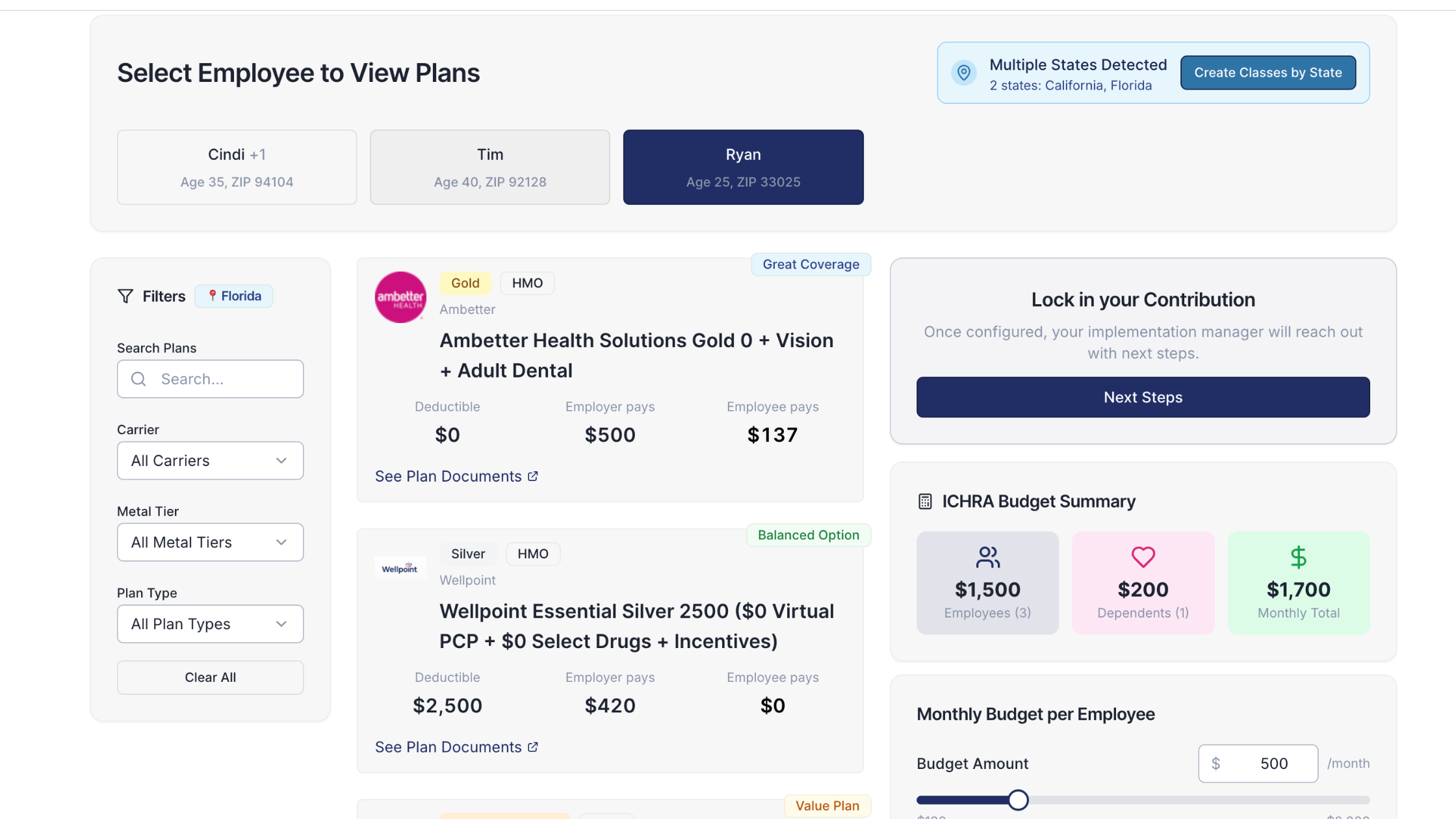Health Savings Account (HSA) Limits: How Much Can You Save in 2026?
%20Limits-%20How%20Much%20Can%20You%20Save%20in%202026%3F%20.jpg)
As you plan your financial and healthcare strategy for the upcoming years, it’s important to stay informed about the tools available to you. A Health Savings Account (HSA) is a powerful way to save for medical expenses and reduce your taxable income. Understanding the HSA contribution limits for 2026 is the first step in maximizing this benefit, giving you more control over your health and financial future. For 2026, the Internal Revenue Service (IRS) has announced that individuals can contribute up to $4,400 for self-only coverage and up to $8,750 for family coverage to their HSAs.
These accounts are more than just a place to put money aside; they are a key part of a modern benefits strategy. At Venteur, we believe in empowering workers with flexible and high-quality health options. An HSA fits perfectly into this vision, offering a way for employees to prepare for tomorrow's healthcare needs today. Whether you're an employer designing a competitive benefits package or an employee planning for your family's well-being, getting to know the updated health savings account limits for 2026 is essential.
Your Guide to Health Savings Accounts
A Health Savings Account is a tax-advantaged savings account that you can use to pay for qualified medical expenses. Think of it as a personal savings account, but with significant tax benefits. To be eligible to open and contribute to an HSA, you must be enrolled in a high-deductible health plan (HDHP). The funds in your HSA can be used for a wide variety of costs, from doctor's visit copays to dental care, and any money you don't use simply rolls over to the next year, continuing to grow tax-free.
The Triple-Tax Advantage: A Closer Look at HSA Tax Benefits in 2026
The primary reason HSAs are so popular is their unique triple-tax advantage. This makes them one of the most tax-efficient savings vehicles available. HSA tax benefits in 2026 are a major advantage for anyone looking to make their healthcare dollars go further.
- Tax-Deductible Contributions: The money you contribute to an HSA is either pre-tax (if done through an employer's payroll) or tax-deductible (if you contribute on your own). This directly lowers your taxable income for the year, meaning you owe less in taxes.
- Tax-Free Growth: Your HSA balance can grow over time through interest and investment earnings, similar to a 401(k). Unlike other investment accounts, this growth is completely tax-free.
- Tax-Free Withdrawals: You can withdraw funds from your HSA at any time to pay for qualified medical expenses without paying any taxes on the money. This includes everything from deductibles and prescriptions to vision and dental care.
Official 2026 HSA Contribution Limits
The IRS adjusts the contribution limits for HSAs annually to account for inflation. For 2026, these limits have seen a slight increase from the previous year, allowing you to set aside more money for your healthcare needs.
Individual Coverage
If you have an HSA-qualified health plan that covers only yourself, the HSA maximum contribution for 2026 is $4,400. This is an increase of $100 from the 2025 limit, providing a little extra room to save.
Family Coverage
For those with a family health plan, the HSA maximum contribution 2026 is $8,750. This represents a $200 increase from 2025, helping families prepare for their collective medical expenses.
The Power of HSA Catch-Up Contributions in 2026
If you are age 55 or older, you can contribute an additional amount to your HSA. These HSA catch up contributions are designed to help those nearing retirement bolster their healthcare savings.
For 2026, the catch-up contribution remains $1,000 per year. If both you and your spouse are over 55 and have your own HSAs, you can each contribute the additional $1,000 to your respective accounts. This means a couple over 55 could potentially save a combined $10,750 if using a family plan, with each spouse contributing their catch-up amount to their own separate HSA.
Who Can Open an HSA? Decoding the Rules for 2026
Understanding eligibility is key to taking advantage of an HSA. Health savings account rules in 2026 are straightforward, but you must meet all the requirements to contribute.
The High-Deductible Health Plan (HDHP) Requirement
The main requirement for contributing to an HSA is being enrolled in a qualified HDHP. For a health plan to be considered an HDHP in 2026, it must meet the following IRS standards:
- Minimum Annual Deductible: The plan must have a deductible of at least $1,700 for self-only coverage or $3,400 for family coverage.
- Maximum Out-of-Pocket Costs: The total annual out-of-pocket expenses (including deductibles, copayments, and other charges, but not premiums) cannot exceed $8,500 for self-only coverage or $17,000 for family coverage.
Other Eligibility Factors
Beyond having an HDHP, you must meet several additional requirements to contribute to an HSA. You cannot be enrolled in any other health coverage that isn't an HDHP—this includes traditional PPO or HMO plans, as well as general-purpose Flexible Spending Accounts (FSAs). You also cannot be enrolled in Medicare or claimed as a dependent on someone else's tax return. These rules ensure that HSAs serve their intended purpose as the primary vehicle for managing healthcare costs under high-deductible coverage.
For employers looking to offer HDHP and HSA combinations as part of a comprehensive benefits package, modern platforms can streamline the entire process. Solutions like Venteur's AI-powered ICHRA platform help employers set predictable, tax-advantaged budgets while giving employees the flexibility to choose high-quality plans that work with their doctors, prescriptions, and budgets.
This approach offers particular advantages for teams implementing HDHP + HSA strategies in 2026. With seamless HR and payroll integrations, employers can easily guide employees to HSA-compatible options and manage contributions efficiently. The result is better coverage for employees and better cost control for organizations, often reducing health spending by up to 30% compared to traditional group plans. Expert support ensures compliance across all 50 states, making the transition simple from setup through ongoing administration.
Maximizing Your HSA: A Strategy for Your Future
An HSA is not just a spending account; it’s a long-term savings and investment tool. For employers and the brokers who advise them, offering an HDHP/HSA combination can be a cornerstone of a modern, cost-effective benefits package. It helps attract and retain talent by giving employees the tools to manage their health and finances effectively.
For even greater flexibility, many companies are exploring solutions like Individual Coverage Health Reimbursement Arrangements (ICHRAs). An ICHRA allows an employer to provide a tax-free allowance for employees to purchase their own health insurance, putting them in complete control. For employees, the decision of whether to spend HSA funds on current medical expenses or save them for the future is a personal one. If you can afford to pay for current medical costs out-of-pocket, allowing your HSA balance to grow can create a substantial nest egg for healthcare expenses in retirement.
You got questions, we got answers!
We're here to help you make informed decisions on health insurance for you and your family. Check out our FAQs or contact us if you have any additional questions.
- Ownership: An HSA is owned by the employee and is portable, meaning you take it with you when you change jobs. An FSA is owned by your employer, and you typically lose the funds if you leave the company.
- Rollover: HSA funds roll over from year to year, allowing you to build a balance over time. Most FSAs are "use-it-or-lose-it," though some employers offer a grace period or a small carryover amount.
- Eligibility: To contribute to an HSA, you must have an HDHP. FSAs can be offered with a wider variety of health plans.
- Contributions: You can change your HSA contribution amount at any time. FSA elections are usually locked in for the plan year unless you have a qualifying life event.
- Deductibles, copayments, and coinsurance
- Prescription medications and over-the-counter drugs with a prescription
- Dental care, including exams, cleanings, and orthodontics
- Vision care, such as eye exams, glasses, and contact lenses
- Chiropractic services and acupuncture
Yes, you can adjust your HSA contribution limits in 2026 at any point during the year. Unlike some other benefit accounts, you are not locked into the amount you chose during open enrollment.
If you are under 65, any money you withdraw for non-qualified expenses is subject to your regular income tax plus a 20% penalty. After you turn 65, you can withdraw funds for any reason without penalty, though you will owe income tax on non-medical withdrawals.
You have until the federal tax filing deadline in 2027, which is typically in mid-April, to make contributions for the 2026 tax year. This flexibility allows you to maximize your savings even after the year has ended.
Explore more related content
What is Venteur
Explore the best human-first Health Insurance platform
Simple, personalized health benefits
Sign up in minutes, define your contribution, and let your employees choose the health plan that works right for them
Integrations to make everything run smoothly
We'll connect with your payroll and finance systems to make deductions and premium payments seamless
Easy onboarding and off-boarding
In just a few clicks, add your roster and make updates on the fly. We'll handle it from there.
Venteur Certified Brokers to help your employees pick the right plan
Our trusted brokers ensure the best outcomes for employees and employers by unlocking health savings and providing unrivaled plan options.
AI-powered plan recommendations to give you confidence while you shop
Backed by 30 years of healthcare data, Venteur’s AI helps employees compare and choose the best plan for their unique situation.
Compliance and reporting because no-duh!
Venteur manages plan administration, reporting, and compliance so you can focus on growing your business.


